Russia's Healthcare System: Problems, Funding, Access, and Solutions
VerifiedAdded on 2023/06/04
|17
|1595
|422
Presentation
AI Summary
This presentation provides a comprehensive analysis of the Russian healthcare system, highlighting key problems such as personnel shortages, inadequate funding, and reduced governmental influence. It examines the funding mechanisms through the Obligatory Medical Insurance (OMI) and compares Russia's healthcare expenditure with other countries, revealing significant disparities. The presentation identifies affected populations, particularly maternity and infant health, and discusses inequalities in healthcare access across different regions and groups. It concludes with recommendations for improvement, including enhanced training for medical workers, evidence-based evaluation of expenditure, and independent budget drafting, aiming to address the identified challenges and enhance the overall quality and effectiveness of the Russian healthcare system.
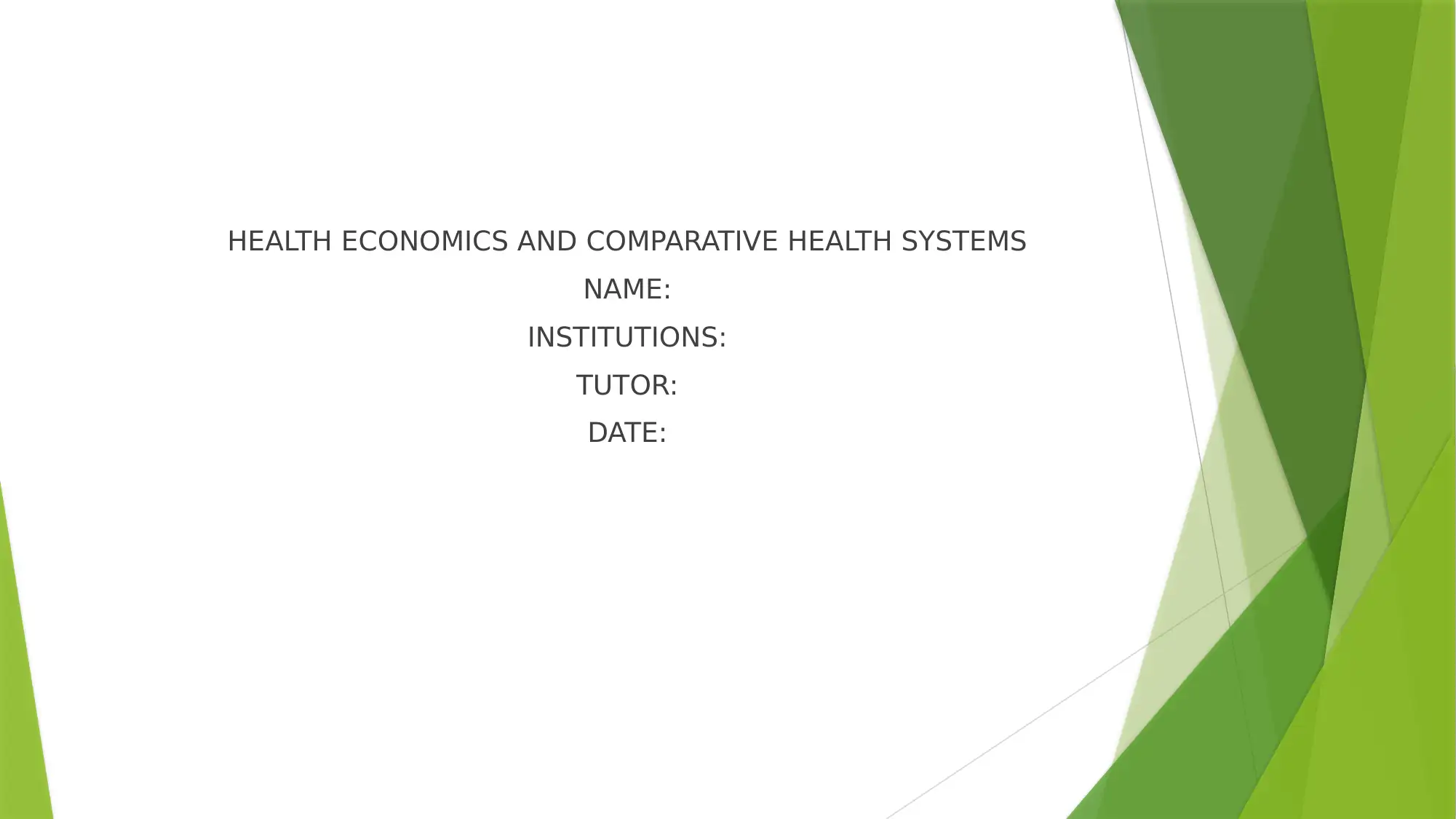
HEALTH ECONOMICS AND COMPARATIVE HEALTH SYSTEMS
NAME:
INSTITUTIONS:
TUTOR:
DATE:
NAME:
INSTITUTIONS:
TUTOR:
DATE:
Paraphrase This Document
Need a fresh take? Get an instant paraphrase of this document with our AI Paraphraser
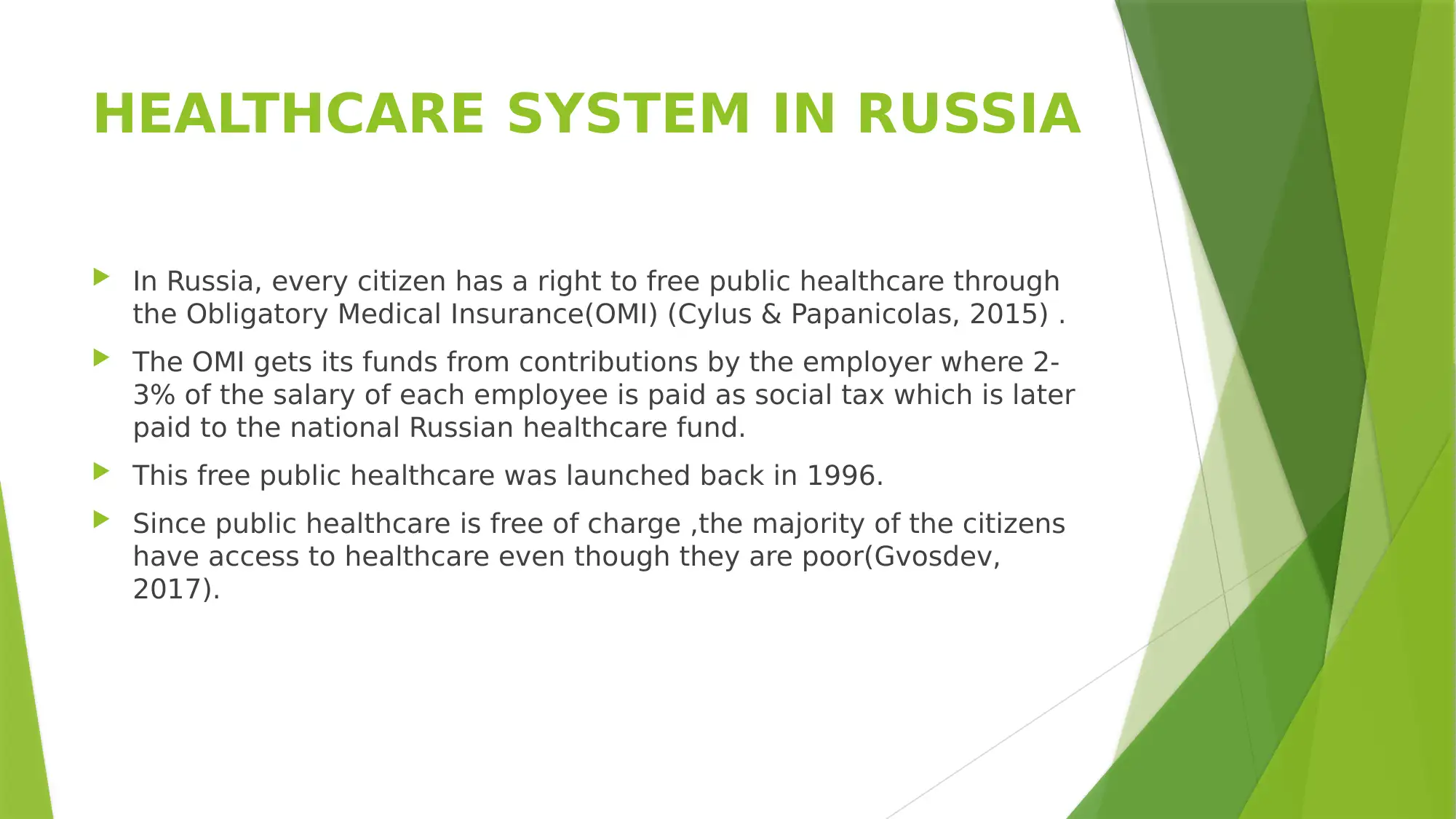
HEALTHCARE SYSTEM IN RUSSIA
In Russia, every citizen has a right to free public healthcare through
the Obligatory Medical Insurance(OMI) (Cylus & Papanicolas, 2015) .
The OMI gets its funds from contributions by the employer where 2-
3% of the salary of each employee is paid as social tax which is later
paid to the national Russian healthcare fund.
This free public healthcare was launched back in 1996.
Since public healthcare is free of charge ,the majority of the citizens
have access to healthcare even though they are poor(Gvosdev,
2017).
In Russia, every citizen has a right to free public healthcare through
the Obligatory Medical Insurance(OMI) (Cylus & Papanicolas, 2015) .
The OMI gets its funds from contributions by the employer where 2-
3% of the salary of each employee is paid as social tax which is later
paid to the national Russian healthcare fund.
This free public healthcare was launched back in 1996.
Since public healthcare is free of charge ,the majority of the citizens
have access to healthcare even though they are poor(Gvosdev,
2017).
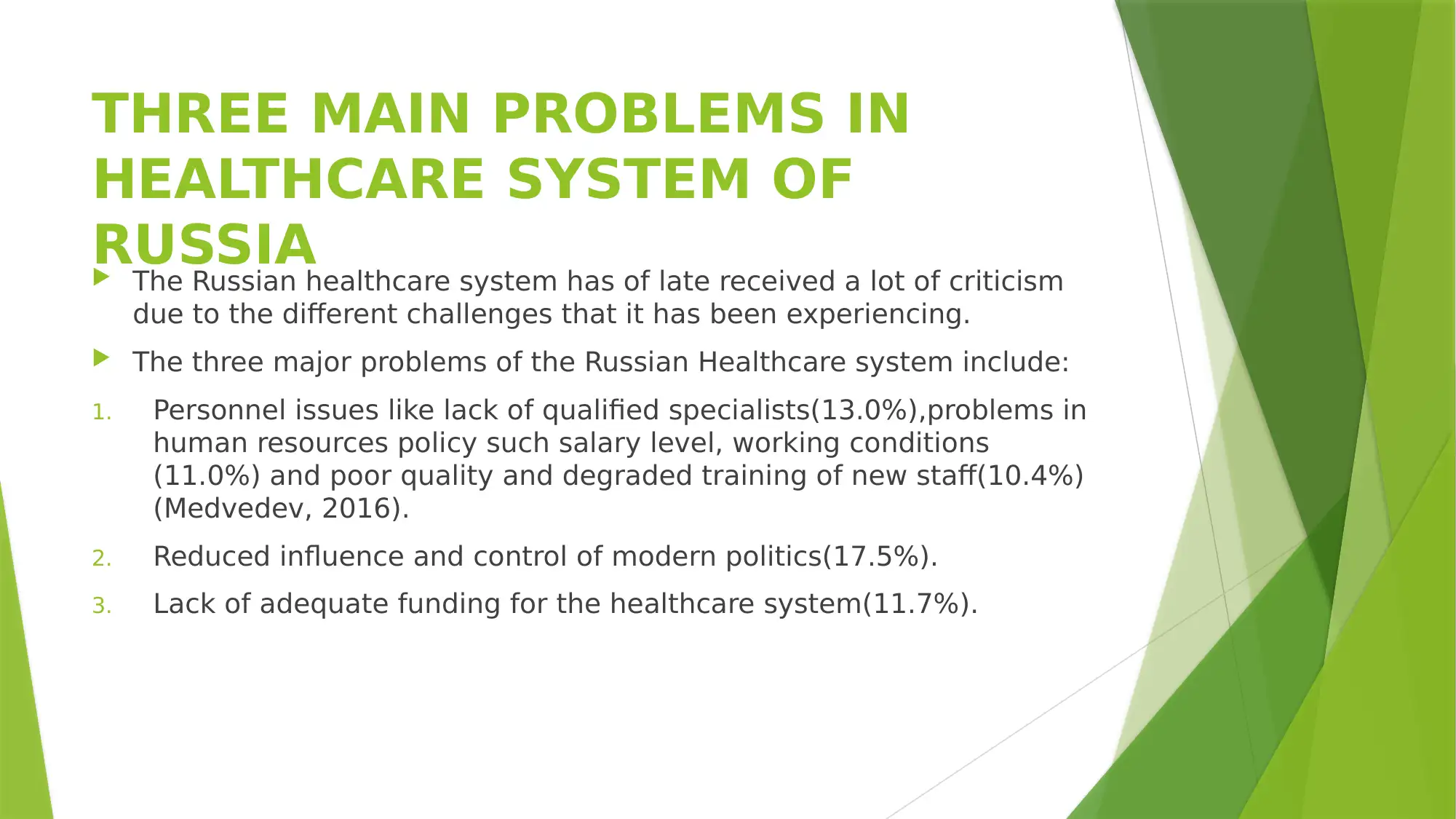
THREE MAIN PROBLEMS IN
HEALTHCARE SYSTEM OF
RUSSIA The Russian healthcare system has of late received a lot of criticism
due to the different challenges that it has been experiencing.
The three major problems of the Russian Healthcare system include:
1. Personnel issues like lack of qualified specialists(13.0%),problems in
human resources policy such salary level, working conditions
(11.0%) and poor quality and degraded training of new staff(10.4%)
(Medvedev, 2016).
2. Reduced influence and control of modern politics(17.5%).
3. Lack of adequate funding for the healthcare system(11.7%).
HEALTHCARE SYSTEM OF
RUSSIA The Russian healthcare system has of late received a lot of criticism
due to the different challenges that it has been experiencing.
The three major problems of the Russian Healthcare system include:
1. Personnel issues like lack of qualified specialists(13.0%),problems in
human resources policy such salary level, working conditions
(11.0%) and poor quality and degraded training of new staff(10.4%)
(Medvedev, 2016).
2. Reduced influence and control of modern politics(17.5%).
3. Lack of adequate funding for the healthcare system(11.7%).
⊘ This is a preview!⊘
Do you want full access?
Subscribe today to unlock all pages.

Trusted by 1+ million students worldwide
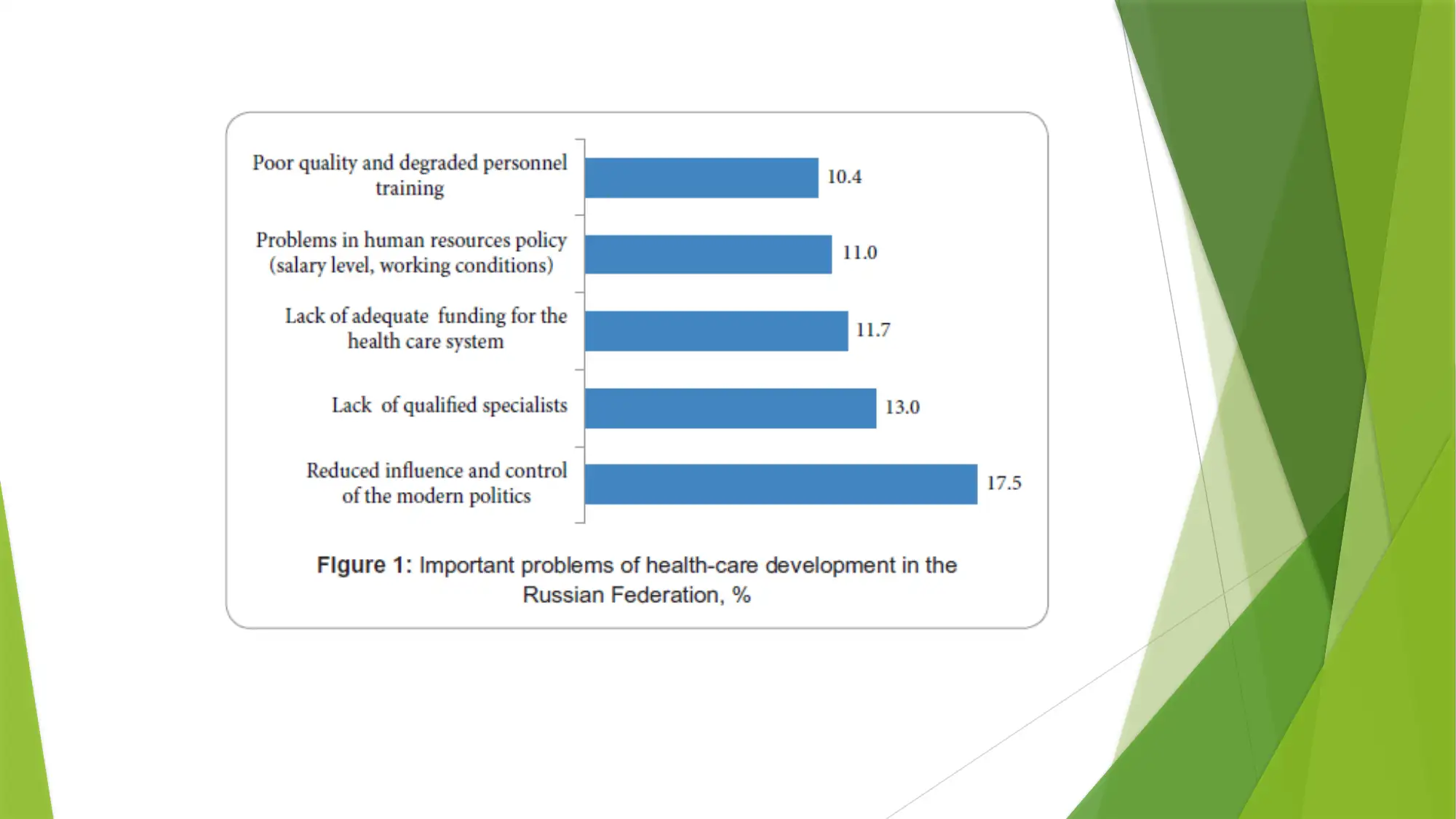
Paraphrase This Document
Need a fresh take? Get an instant paraphrase of this document with our AI Paraphraser
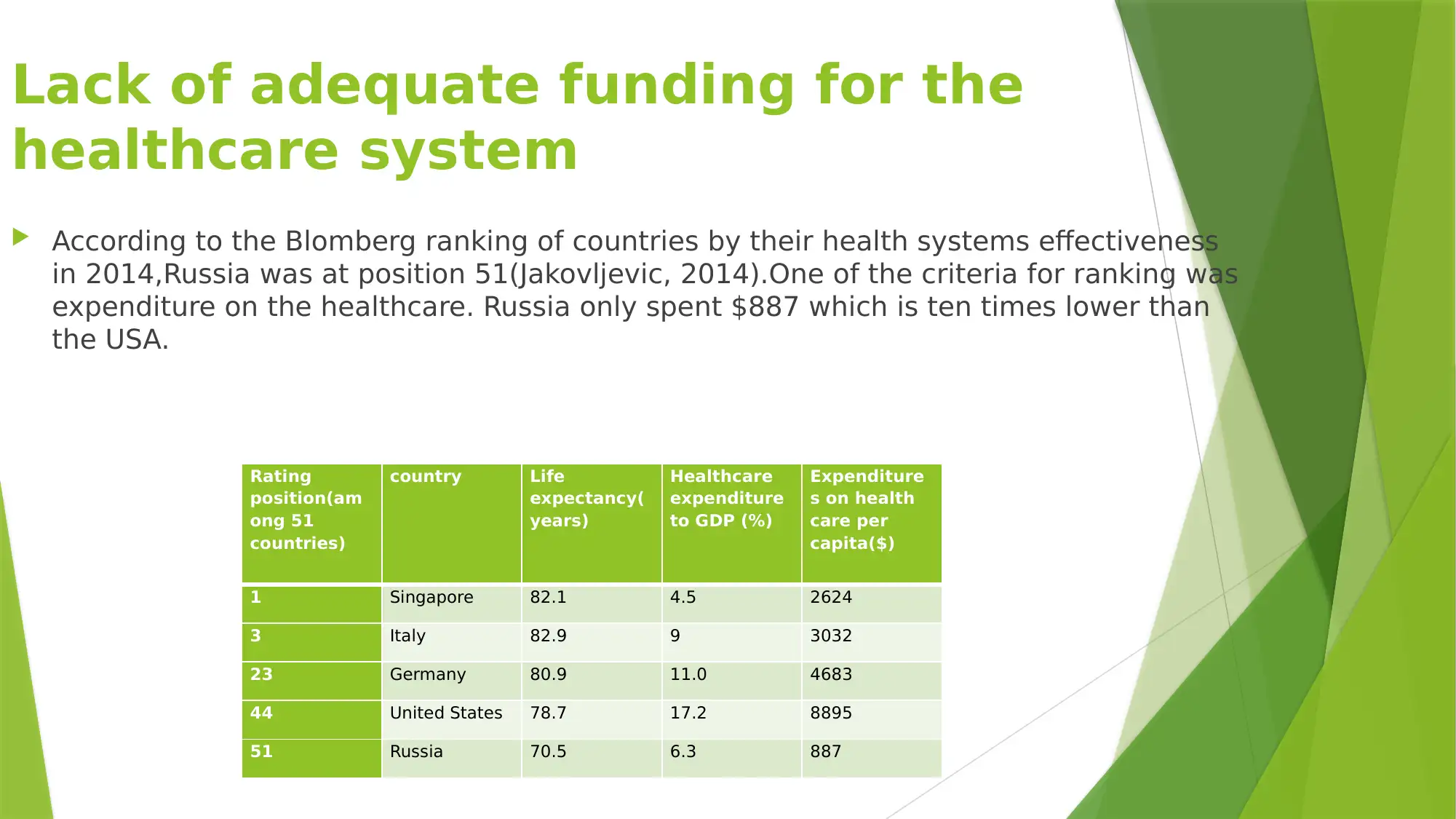
Lack of adequate funding for the
healthcare system
According to the Blomberg ranking of countries by their health systems effectiveness
in 2014,Russia was at position 51(Jakovljevic, 2014).One of the criteria for ranking was
expenditure on the healthcare. Russia only spent $887 which is ten times lower than
the USA.
Rating
position(am
ong 51
countries)
country Life
expectancy(
years)
Healthcare
expenditure
to GDP (%)
Expenditure
s on health
care per
capita($)
1 Singapore 82.1 4.5 2624
3 Italy 82.9 9 3032
23 Germany 80.9 11.0 4683
44 United States 78.7 17.2 8895
51 Russia 70.5 6.3 887
healthcare system
According to the Blomberg ranking of countries by their health systems effectiveness
in 2014,Russia was at position 51(Jakovljevic, 2014).One of the criteria for ranking was
expenditure on the healthcare. Russia only spent $887 which is ten times lower than
the USA.
Rating
position(am
ong 51
countries)
country Life
expectancy(
years)
Healthcare
expenditure
to GDP (%)
Expenditure
s on health
care per
capita($)
1 Singapore 82.1 4.5 2624
3 Italy 82.9 9 3032
23 Germany 80.9 11.0 4683
44 United States 78.7 17.2 8895
51 Russia 70.5 6.3 887
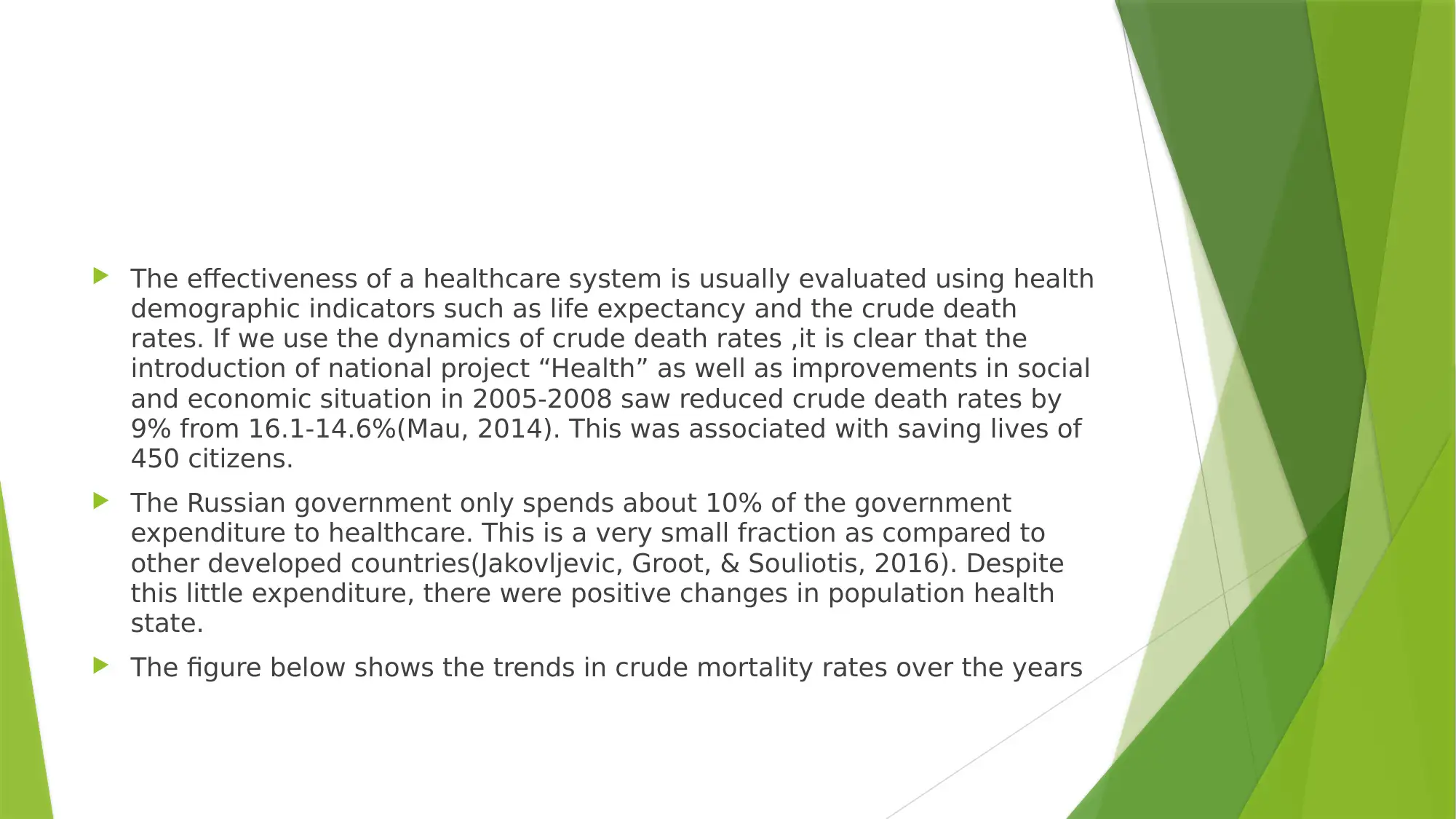
The effectiveness of a healthcare system is usually evaluated using health
demographic indicators such as life expectancy and the crude death
rates. If we use the dynamics of crude death rates ,it is clear that the
introduction of national project “Health” as well as improvements in social
and economic situation in 2005-2008 saw reduced crude death rates by
9% from 16.1-14.6%(Mau, 2014). This was associated with saving lives of
450 citizens.
The Russian government only spends about 10% of the government
expenditure to healthcare. This is a very small fraction as compared to
other developed countries(Jakovljevic, Groot, & Souliotis, 2016). Despite
this little expenditure, there were positive changes in population health
state.
The figure below shows the trends in crude mortality rates over the years
demographic indicators such as life expectancy and the crude death
rates. If we use the dynamics of crude death rates ,it is clear that the
introduction of national project “Health” as well as improvements in social
and economic situation in 2005-2008 saw reduced crude death rates by
9% from 16.1-14.6%(Mau, 2014). This was associated with saving lives of
450 citizens.
The Russian government only spends about 10% of the government
expenditure to healthcare. This is a very small fraction as compared to
other developed countries(Jakovljevic, Groot, & Souliotis, 2016). Despite
this little expenditure, there were positive changes in population health
state.
The figure below shows the trends in crude mortality rates over the years
⊘ This is a preview!⊘
Do you want full access?
Subscribe today to unlock all pages.

Trusted by 1+ million students worldwide

Paraphrase This Document
Need a fresh take? Get an instant paraphrase of this document with our AI Paraphraser
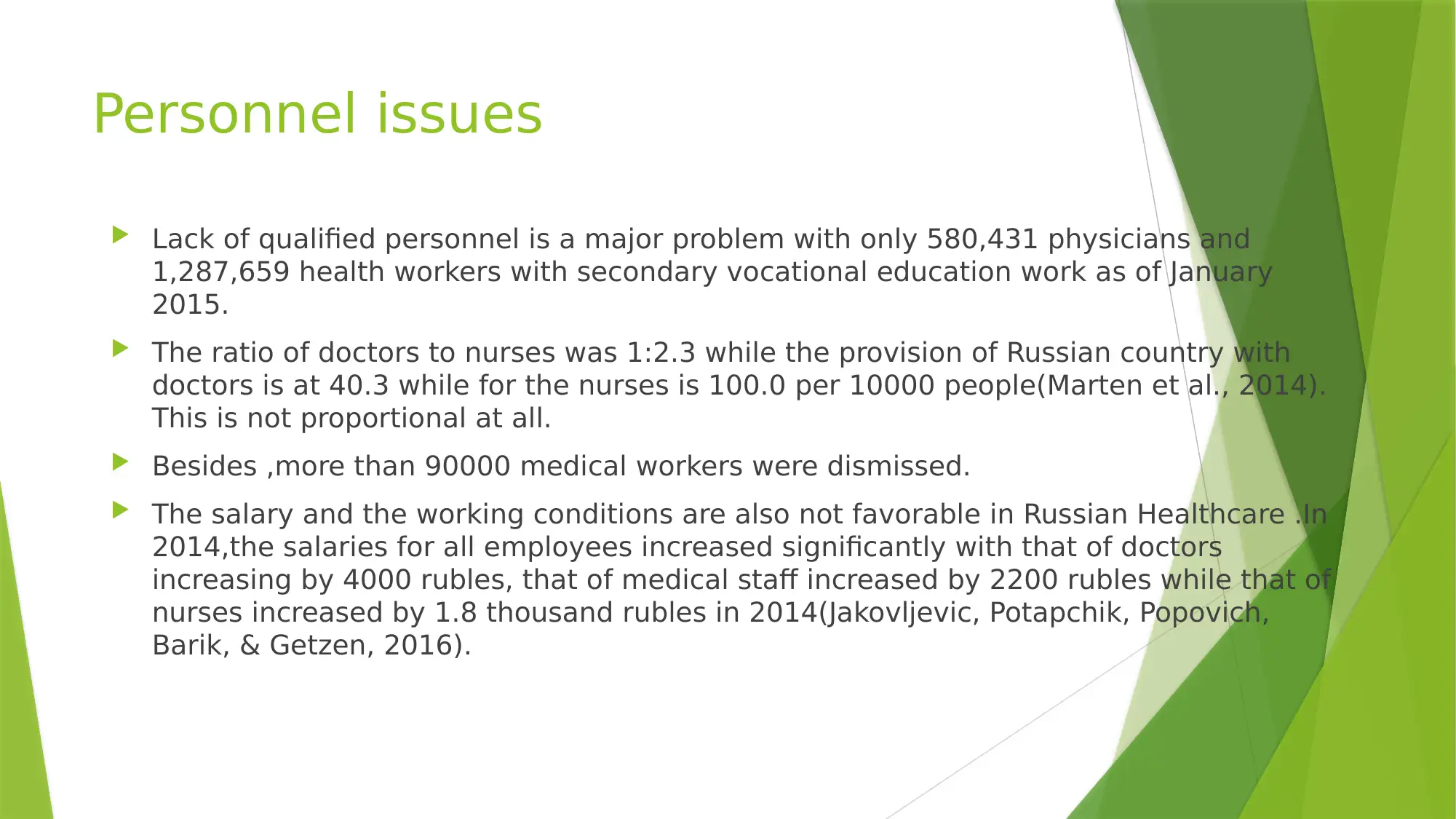
Personnel issues
Lack of qualified personnel is a major problem with only 580,431 physicians and
1,287,659 health workers with secondary vocational education work as of January
2015.
The ratio of doctors to nurses was 1:2.3 while the provision of Russian country with
doctors is at 40.3 while for the nurses is 100.0 per 10000 people(Marten et al., 2014).
This is not proportional at all.
Besides ,more than 90000 medical workers were dismissed.
The salary and the working conditions are also not favorable in Russian Healthcare .In
2014,the salaries for all employees increased significantly with that of doctors
increasing by 4000 rubles, that of medical staff increased by 2200 rubles while that of
nurses increased by 1.8 thousand rubles in 2014(Jakovljevic, Potapchik, Popovich,
Barik, & Getzen, 2016).
Lack of qualified personnel is a major problem with only 580,431 physicians and
1,287,659 health workers with secondary vocational education work as of January
2015.
The ratio of doctors to nurses was 1:2.3 while the provision of Russian country with
doctors is at 40.3 while for the nurses is 100.0 per 10000 people(Marten et al., 2014).
This is not proportional at all.
Besides ,more than 90000 medical workers were dismissed.
The salary and the working conditions are also not favorable in Russian Healthcare .In
2014,the salaries for all employees increased significantly with that of doctors
increasing by 4000 rubles, that of medical staff increased by 2200 rubles while that of
nurses increased by 1.8 thousand rubles in 2014(Jakovljevic, Potapchik, Popovich,
Barik, & Getzen, 2016).
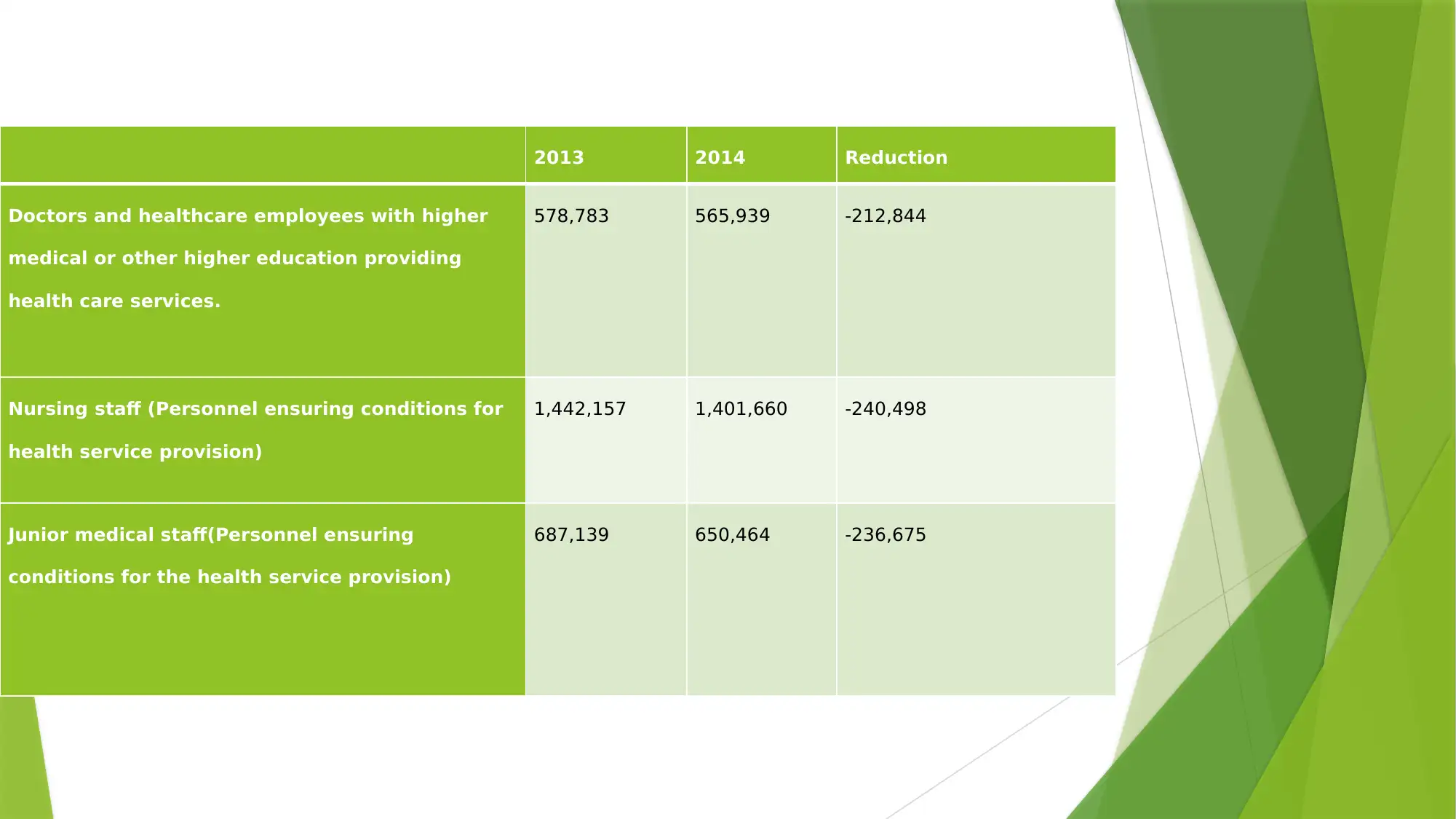
2013 2014 Reduction
Doctors and healthcare employees with higher
medical or other higher education providing
health care services.
578,783 565,939 -212,844
Nursing staff (Personnel ensuring conditions for
health service provision)
1,442,157 1,401,660 -240,498
Junior medical staff(Personnel ensuring
conditions for the health service provision)
687,139 650,464 -236,675
Doctors and healthcare employees with higher
medical or other higher education providing
health care services.
578,783 565,939 -212,844
Nursing staff (Personnel ensuring conditions for
health service provision)
1,442,157 1,401,660 -240,498
Junior medical staff(Personnel ensuring
conditions for the health service provision)
687,139 650,464 -236,675
⊘ This is a preview!⊘
Do you want full access?
Subscribe today to unlock all pages.

Trusted by 1+ million students worldwide
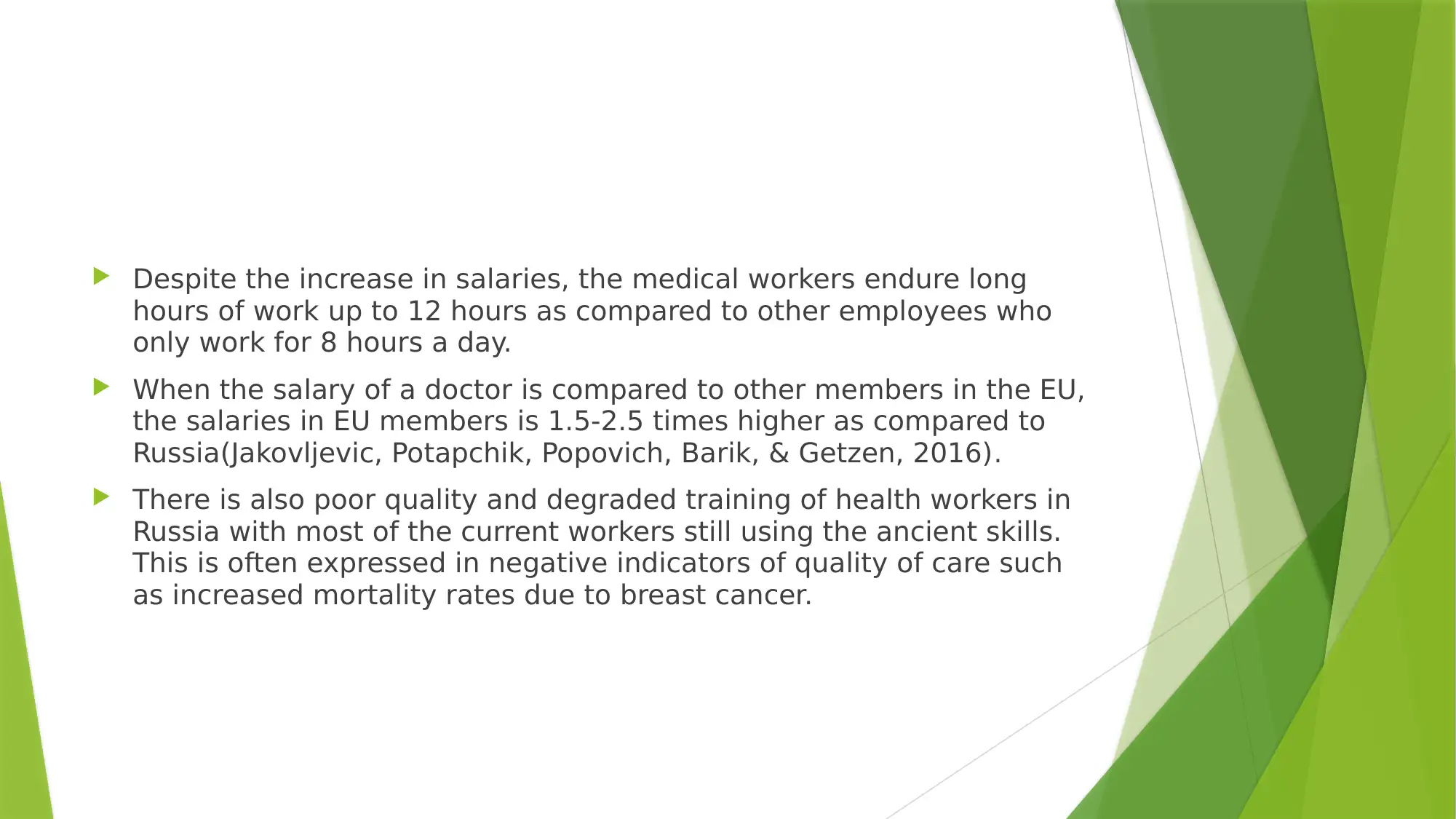
Despite the increase in salaries, the medical workers endure long
hours of work up to 12 hours as compared to other employees who
only work for 8 hours a day.
When the salary of a doctor is compared to other members in the EU,
the salaries in EU members is 1.5-2.5 times higher as compared to
Russia(Jakovljevic, Potapchik, Popovich, Barik, & Getzen, 2016).
There is also poor quality and degraded training of health workers in
Russia with most of the current workers still using the ancient skills.
This is often expressed in negative indicators of quality of care such
as increased mortality rates due to breast cancer.
hours of work up to 12 hours as compared to other employees who
only work for 8 hours a day.
When the salary of a doctor is compared to other members in the EU,
the salaries in EU members is 1.5-2.5 times higher as compared to
Russia(Jakovljevic, Potapchik, Popovich, Barik, & Getzen, 2016).
There is also poor quality and degraded training of health workers in
Russia with most of the current workers still using the ancient skills.
This is often expressed in negative indicators of quality of care such
as increased mortality rates due to breast cancer.
Paraphrase This Document
Need a fresh take? Get an instant paraphrase of this document with our AI Paraphraser
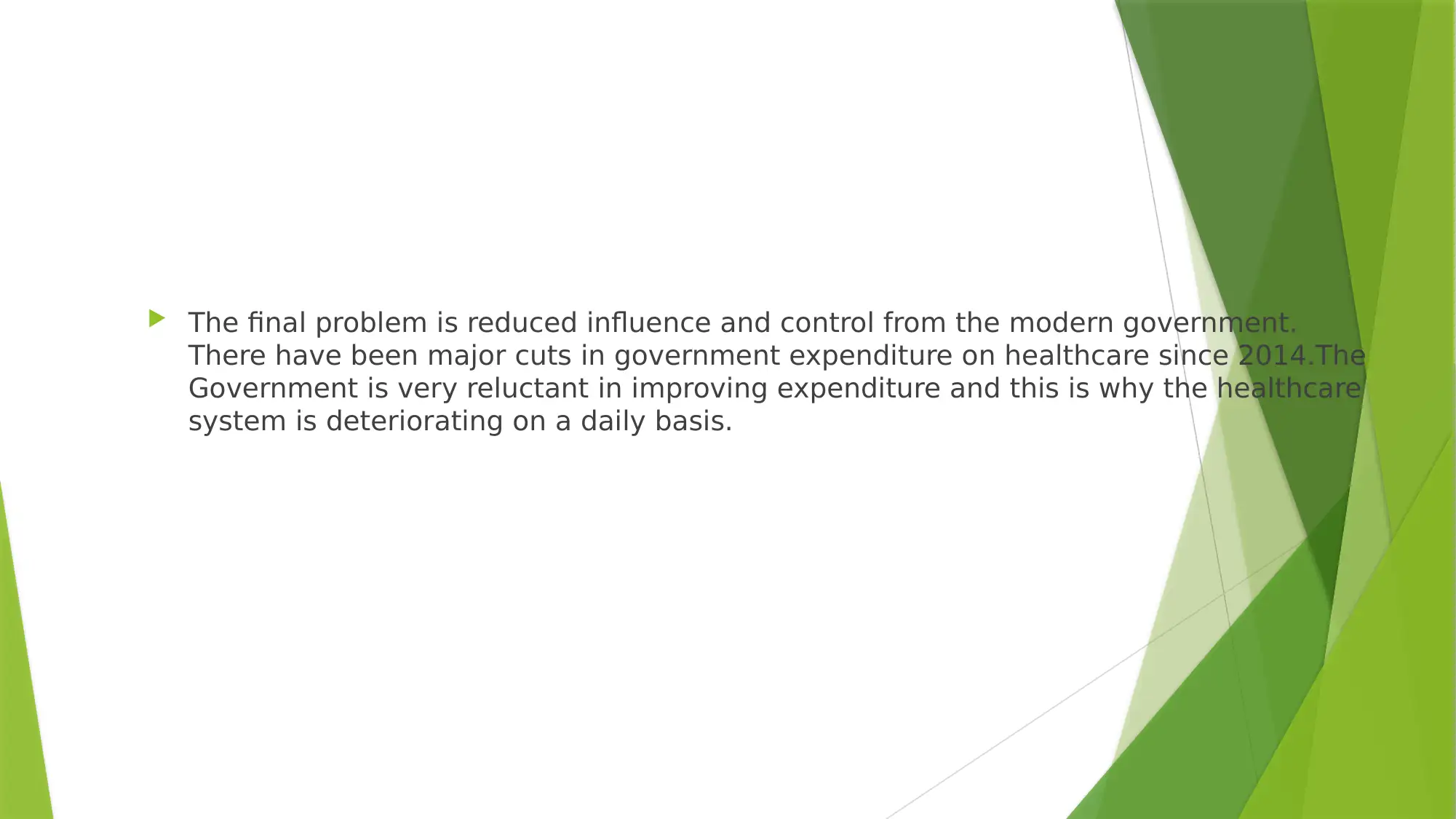
The final problem is reduced influence and control from the modern government.
There have been major cuts in government expenditure on healthcare since 2014.The
Government is very reluctant in improving expenditure and this is why the healthcare
system is deteriorating on a daily basis.
There have been major cuts in government expenditure on healthcare since 2014.The
Government is very reluctant in improving expenditure and this is why the healthcare
system is deteriorating on a daily basis.
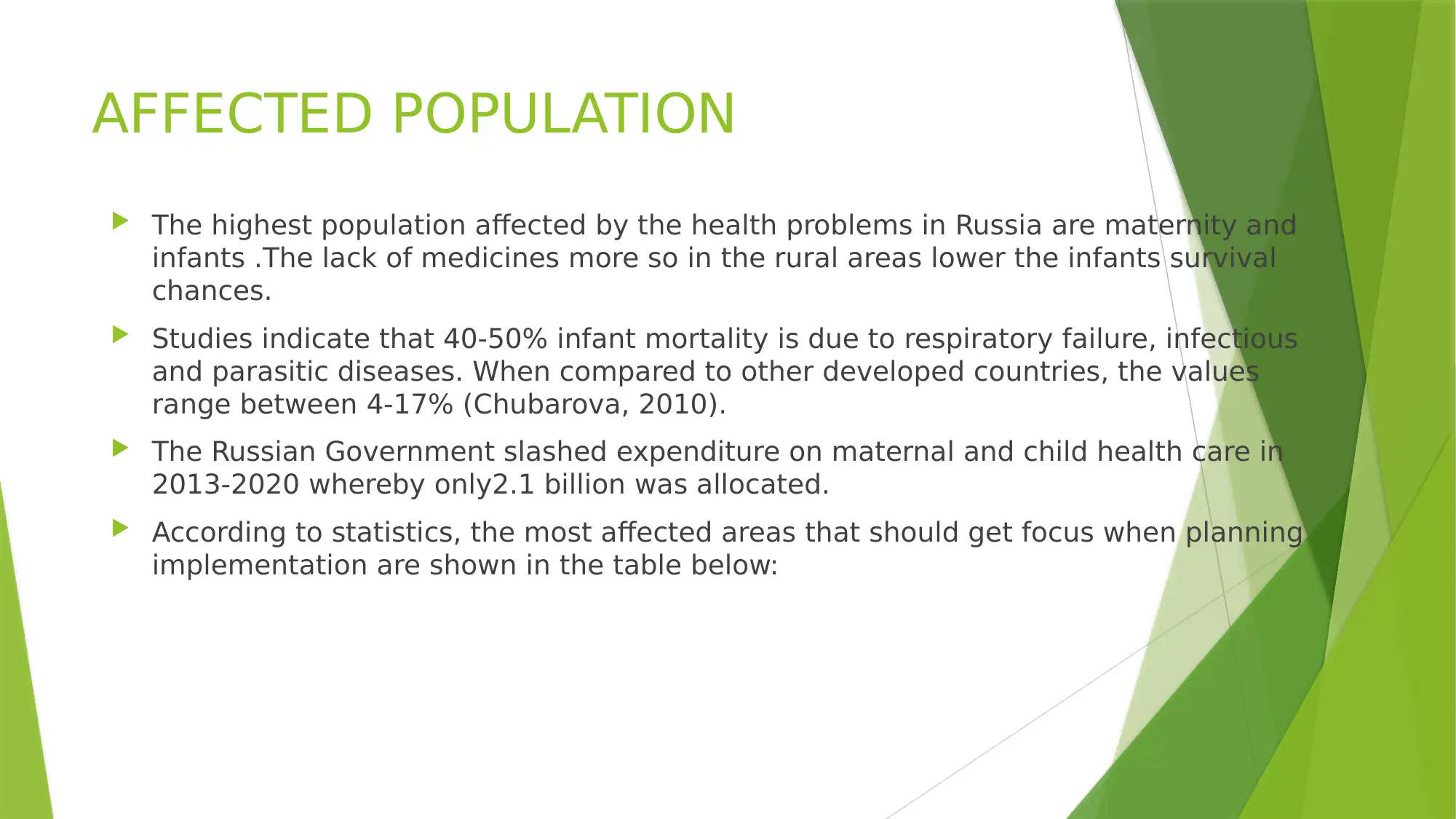
AFFECTED POPULATION
The highest population affected by the health problems in Russia are maternity and
infants .The lack of medicines more so in the rural areas lower the infants survival
chances.
Studies indicate that 40-50% infant mortality is due to respiratory failure, infectious
and parasitic diseases. When compared to other developed countries, the values
range between 4-17% (Chubarova, 2010).
The Russian Government slashed expenditure on maternal and child health care in
2013-2020 whereby only2.1 billion was allocated.
According to statistics, the most affected areas that should get focus when planning
implementation are shown in the table below:
The highest population affected by the health problems in Russia are maternity and
infants .The lack of medicines more so in the rural areas lower the infants survival
chances.
Studies indicate that 40-50% infant mortality is due to respiratory failure, infectious
and parasitic diseases. When compared to other developed countries, the values
range between 4-17% (Chubarova, 2010).
The Russian Government slashed expenditure on maternal and child health care in
2013-2020 whereby only2.1 billion was allocated.
According to statistics, the most affected areas that should get focus when planning
implementation are shown in the table below:
⊘ This is a preview!⊘
Do you want full access?
Subscribe today to unlock all pages.

Trusted by 1+ million students worldwide
1 out of 17
Your All-in-One AI-Powered Toolkit for Academic Success.
+13062052269
info@desklib.com
Available 24*7 on WhatsApp / Email
![[object Object]](/_next/static/media/star-bottom.7253800d.svg)
Unlock your academic potential
Copyright © 2020–2025 A2Z Services. All Rights Reserved. Developed and managed by ZUCOL.
